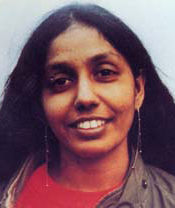- Rajini Thiranagama
Infobox Person
name = Dr. Rajini Thiranagama

image_size = 175px
caption = Dr. Rajini Thiranagama
birth_date = birth date|1954|2|23|mf=y
birth_place =Jaffna , Sri Lanka
death_date = death date and age|1989|9|21|1954|2|23|mf=y
death_place = Jaffna, Sri Lanka
occupation = University Lecturer
spouse = Dayapala Thiranagama
parents =
children = Narmada Thiranagama,Sharika Thiranagama Dr. Rajini Thiranagama (nee Rajasingham) (February 23 ,1954 -September 21 ,1989 ) was a Tamil human rights activist and feminist who was shot dead byTamil Tigers cadres after she criticised them for their atrocities.cite web|url=http://www.uthr.org/Statements/Release%20of%20Film%20on%20Rajani%20-%20No%20more%20tears%20sister.htm|title=On the occasion of the release of No More Tears Sister, a film on the life and times of Rajani Thiranagama|accessdate=2007-02-12] At the time of her assassination she was the head of the Department of Anatomy at theUniversity of Jaffna and an active member ofUniversity Teachers for Human Rights , Jaffna branch of which she is one of the founding members.Biography
Early life and education
Rajini was born in
Jaffna , in northernSri Lanka , to middle-class TamilChristian parents. She was the second child of the four female children. She followed her primary and secondary school education in Jaffna and in 1973, she entered theUniversity of Colombo to study medicine. At university, she became actively involved in student politics. cite web|url=http://www.sangam.org/PIRABAKARAN/Part24.htm|title=Surviving the Plots of RAW and Premadasa|accessdate=2006-11-22]Marriage and children
During her stay at Colombo University she met a politically active student leader from
Kelaniya University named Dayapala Thirangama. Dayapala was from a rural Sinhala Bhudist background. Rajani broke ethnic and religious barriers and married Dayapala in1977. They had two daughters: Narmada, (1978), and Sharika, 1980. At present Rajini's husband and her two daughters live inEngland . In 2005 Sharika portrayed her mother's role in the documetary film on Rajini called "No More Tears Sister".Medical Profession
1978 Rajani begins her first posting as an intern medical doctor at Jaffna Hospital. After the completion of the intern, in 1979 she traveled to
Haldumulla , a small village situated nearHaputale to work as a medical doctor. By 1980 she returned to Jaffna as a lecturer in anatomy in the newly-formed Faculty of Medicine at the University of Jaffna. By this time, Jaffna was a battle zone in the early stages of Sri Lanka's civil war. Many were leaving Jaffna forColombo or migrating to other countries including theUnited Kingdom ,Canada , andAustralia .Links with the LTTE
Inspired by her elder sister Nirmala, then a member of
Liberation Tigers of Tamil Eelam , Rajani became involved with theLTTE , administering care to those wounded in action. In 1983, Rajani traveled toEngland under Commonwealth scholarship for postgraduate studies in anatomy at Liverpool Medical School. There she launched a major international campaign for the release of her sister who was imprisoned in 1982 in under Sri Lanka's Prevention of Terrorism Act. She also maintained her links with LTTE by joining its London Committee in order to educate human rights groups and other international organizations about the atrocities occurring in Sri Lanka. While continuing to write and publish scientific papers, she also became implicated in grassroots organizations fighting for women’s rights and against the discrimination of Britain’s black people [cite web|url=http://www.defence.lk/new.asp?fname=20070212_10|title=South African LTTE Connections Exposed, By Rohan Gunaratna|accessdate=2007-02-12] and became involved in the international campaigns of other liberation groups. cite web|url=http://www.nfb.ca/webextension/nomoretearssister/pdf/press_kit.pdf|title=RAJANI THIRANAGAMA BIOGRAPHY|accessdate=2006-11-22]As a human rights activist
Over time, constant exposure to politically motivated killings by armed groups on all sides caused Rajani to rethink her position on armed struggle. [cite web|url=http://www.tamilnation.org/books/eelam/hoole.htm|title=RAJANI THIRANAGAMA HISTORY OF CONFLICT|accessdate=2006-11-22] A determined idealist, she criticized the narrow nationalism of the LTTE, and the atrocities committed by the LTTE, the
Indian Peace Keeping Force and the Sri Lankan government forces upon the innocent Tamil civilian population in Jaffna. She began to collect evidence of human rights violations ofIPKF and LTTE.At the University of Jaffna, Rajini and some of her teacher colleagues founded the Jaffna branch of the "University Teachers for Human Rights ".
Wikimedia Foundation. 2010.
